Léfkes - Panagía Thapsanoón - Parikiá
Evaluation: This long walk follows the same route as the walk Parikiá - Panagía Thapsanoón - Léfkes, but in reverse. It thus follows beautiful trails through the interior of the island - most of these trails are not (yet) on the map of Terrain Maps or Anavasi...
This hike can optionally form the continuation of the classic walk Pródromos - Léfkes, the so called "Byzantine Road". Deserves the evaluation ***.
[Updated by Raymond on May 17, 2013.]
[The translation of this walk was made with some help of Google translate - so, do not mind the mistakes...]
Estimated time: The actual walking time (AWT) up to the hamlet of Pígados is a little less than an hour, and then it takes half an hour to get to the Panagía Thapsanoón. The final stretch to Parikiá requires 1h20. The AWT of the total walk thus amounts to 2h50 – but the total time (TWT) can be the double, some 5 to 6 hours...
Route description: (0h00) There is near the bus stop of Léfkes a street that goes straight to the center of Léfkes, while the main road turns down to the left to Pródromos (there is parking a little below). You go back for a few moments on the road to Parikiá, but almost immediately you can take on the left a paved slope (hiking sign to Maráthi / Parikiá, the only sign of the whole hike!).
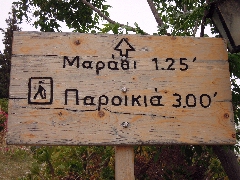
The hiking sign in Léfkes.
You pass just next to some houses, and a little further you get to the upper asphalt road that you follow to the right until beyond the crossroads. You there see on the left side the continuation of the walk, a small road that follows the route of the Byzantine road: the pavement is very nice and the descent is steep.
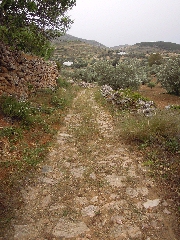
A stretch of the "Byzantine road".
You already can see, on the other slope of the valley, the path you will follow, with a chapel and a house, where the path will run between two walls ...
After about 5 minutes, you get by a concrete slope to the asphalt road - the little road continues on the other side towards the Byzantine bridge (sign-post), but it is better to follow the road to the left. You pass the modern bridge (with a nice view of the Byzantine bridge), and then you still continue for 100 meters.
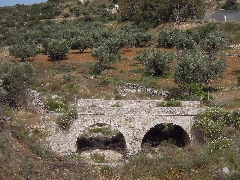
The Byzantine bridge, near Léfkes.
(0h12) You then take the gravel road to the left, but at a gate, you go right for a while and immediately left, and in this way you go up on a small gravel road next to a heavy wall. The rise is slow at first, but becomes steeper on the concrete. Past a turn of the road, you arrive next to the chapel you had seen earlier, and here you take a sharp right. You pass under a power line, then veer left to return under the cables and immediately you go right again and then left on a beautiful trail with an uneven pavement.
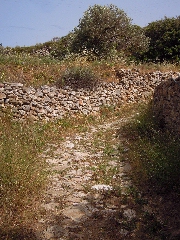
The nice monopáti to Pígados.
(0h21) You now ascend quickly next to a wall, you pass a house after 5 minutes and you continue to rise between two walls, as you had also seen before. After a left turn, the trail becomes more rocky, but continues afterwards with a very uneven pavement. You thus approach a house situated below a windy pass.
You pass underneath the house, you go through a gate in reinforcing steel and you go immediately to the right on a concrete slope; you veer left and you pass in this way on the right side of the house - and then you reach the pass.
(0h45) You start the descent on the concrete road, with already far ahead the huge monastery in pink and red. There is a sharp turn to the right after 6 minutes – it is a pity that there is no trail or road that continues in the right direction... After another 6 minutes, you get to a crossroad: you see the chapel of Agios Geórgios on the right, to the left there is a house with a beautiful garden - it is the hamlet of Pígados.
[The road to the right continues to Agios Minás and Maráthi.]
(0h57) You follow the gravel road to the left and continue to follow it straight after 4-5 minutes, while passing next to a ruin, then above the chapel of Agia Kyriakí. When the path describes a sharp turn, near an electricity pole, you find an overgrown trail that continues straight.
(1h02) You pass a pretty ugly pigeon house, while it remains difficult to follow the trail because of the tall grass, especially in spring. The trail gets better after 4 minutes, then it goes down between walls in a valley, with a vineyard on the right side.
(1h09) Once at the bottom, you go left, but pay attention now: 50 meters further and just before you reach a border of reeds on the left slope, you should seek the path that rises sharply to the right, but that is almost invisible because of the broom. This narrow path with its very uneven pavement goes up quickly in sharp turns; after 5 minutes, there is a very overgrown and flat stretch. You climb again, the trail becomes difficult and then more clear again – and the monastery appears in front of you. Finally, you get to a small gravel road, about 15 meters to the left of a gate.
(1h25) You take a left of course and you thus arrive to the right of the large "sweet" building of the Panagía Thapsanoón.
(1h31) You get here to a larger gravel road where you go left to the entrance of the monastery – it is quite modern, since it only dates from the year 1939; it is a nunnery and only “decently” dressed women can get in.
You also have a beautiful view of the coast of Páros with in the sea Náxos (to the left) and the island of Ios (to the right).
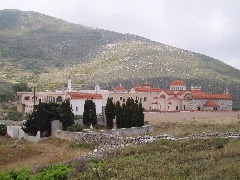
The monastery of the Panagía Thapsanoón.
(1h33) For the continuation of the walk, you should retrace your steps for a few moments while following the wall of the convent and you continue until the gravel road splits up, near a large electricity pole. You take a left, but immediately thereafter you find a concrete path off the left again. This path descends between walls, straight in the direction of the faraway bay of Parikiá.
The concrete finishes after 4 minutes and then you have to go through a metal gate – by untying it on the right-hand side. For the following 4-5 minutes your trail continues until you get above the Péra Panagía. At a couple of ruins you go down on the left; you have to open another gate and then you take the narrow path going down, on the left of the second gate. Slightly further you pass the house and the chapel – strikingly enough you have to climb over a wall in order to get to the chapel.
You continue going down and you thus reach the bottom of the bed of the river. You climb over a barrier of branches and the trail is overgrown, but on the other bank you take a right and the trail becomes a lot clearer.
(1h44) You continue and you get a beautiful view on the Péra Panagía again.
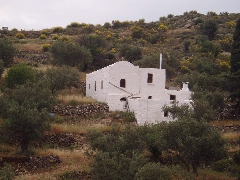
The Péra Panagía.
You get to a few subsidences and slightly further the trail is also overgrown again. After 4-5 minutes, though, the monopáti becomes broader and it descends between broom and olive trees. The trail gets even broader and shortly thereafter you go straight ahead, obviously. Some 2 minutes later the trail becomes narrower and stony; all together about 14 minutes after your departure from the bed of the river underneath Péra Panagía you reach the stony bed of the river besides the filling station again.
(1h58) You clamber towards the left inside the bed, you sometimes find a small stretch of trail on the right, you then arrive in the bed again, and you follow a small stretch of trail on your left-hand side. You proceed in the bed, but after about 6 minutes you finally find a real road.
(2h04) For a couple of minutes you rise above the valley and then you gradually go down for about 15 minutes, first with a view on the sea and then on Parikiá.
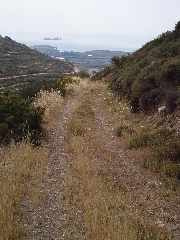
The descent towards Parikiá.
Towards the end the road becomes rockier and then it turns into a gravel road. About 17 minutes after the valley you thus reach the first house and the beginning of a concrete road.
(2h21) After 3 minutes you get to another street, just before the sports field. You go left for about one minute and then you take the gravel road off the right.
(2h25) A couple of minutes later the road turns into concrete again and then you continue straight ahead all the time – for about 15-16 minutes, until you reach the ring road of Parikiá. You then follow the meandering street for another 5 minutes until you arrive at the mitrópoli, recognizable by the blue domes and the double towers.
(2h48) You find the centre of Parikiá on your right-hand side.